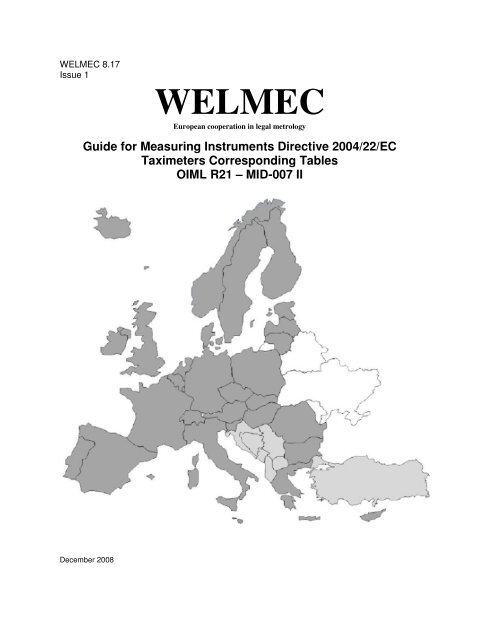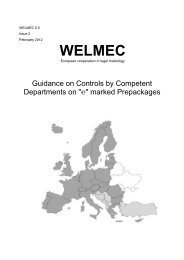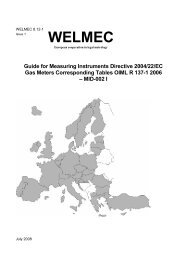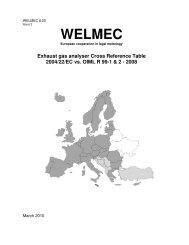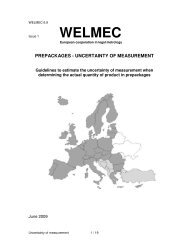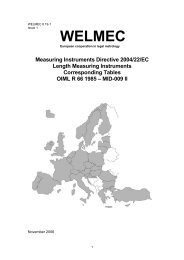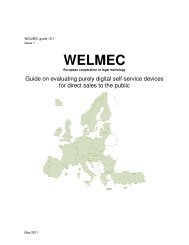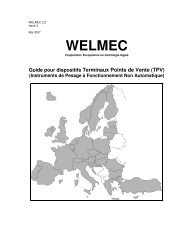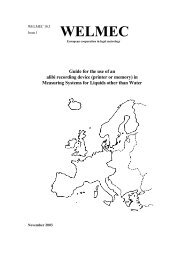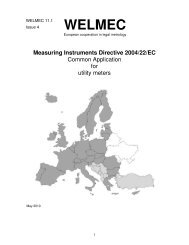Guide for Measuring Instruments Directive 2004/22/EC ... - WELMEC
Guide for Measuring Instruments Directive 2004/22/EC ... - WELMEC
Guide for Measuring Instruments Directive 2004/22/EC ... - WELMEC
Create successful ePaper yourself
Turn your PDF publications into a flip-book with our unique Google optimized e-Paper software.
WELM<strong>EC</strong> 8.17Issue 1WELM<strong>EC</strong>European cooperation in legal metrology<strong>Guide</strong> <strong>for</strong> <strong>Measuring</strong> <strong>Instruments</strong> <strong>Directive</strong> <strong>2004</strong>/<strong>22</strong>/<strong>EC</strong>Taximeters Corresponding TablesOIML R21 – MID-007 IIDecember 2008
WELM<strong>EC</strong>European cooperation in legal metrologyWELM<strong>EC</strong> is a cooperation between the legal metrologyservices of the Member States of the European Union andEFTA. This document is one of a number of <strong>Guide</strong>s published byWELM<strong>EC</strong> to provide guidance to packers, importers and thecompetent departments responsible <strong>for</strong> ensuring that prepackagesmeet the specified requirements. The <strong>Guide</strong>s are purely advisoryand do not themselves impose any restrictions or additionaltechnical requirements beyond those contained in relevant <strong>EC</strong><strong>Directive</strong>s.Alternative approaches may be acceptable, but the guidanceprovided in this document represents the considered view ofWELM<strong>EC</strong> as to the best practice to be followed.Published by:WELM<strong>EC</strong> SecretariatBEVSchiffamtsgasse 1-3A-1020 ViennaAustriaTel: +43 1 211 10 2711Fax: +43 1 211 10 4701
TaximetersCross Reference Table <strong>2004</strong>/<strong>22</strong>/<strong>EC</strong> vs. OIML R 21 (2007)Notes:1. The column “Comments” indicates when necessary the relevant text of OIML R 21 and related explanations concerning the compliance with relevant MIDrequirement.2. The column “Conclusion” gives the conclusion on the compliance between MID and OIML R 21 <strong>for</strong> the relevant requirement.The indication “Covered” means that:- The requirement of OIML R 21 is identical to the one of MID; or- The requirement of OIML R 21 is more severe than the one of MID; or- All the requirement of OIML R 21 fulfils MID requirements (even when MID allows other alternatives),- In case the requirement is not fully covered, a short statement explains what is covered.The indication “Not Covered” means that the MID requirement is either not compatible with the relevant OIML R 21 requirement or not included inOIML R 21.The indication “Not relevant” means that the MID Annex 1 requirement is not relevant <strong>for</strong> taximeters.Page 3 of 30September 2008BIML
<strong>Directive</strong> <strong>2004</strong>/<strong>22</strong>/<strong>EC</strong>Essential requirements of Annex 1 andAnnex MI-007 Chapter IVOIML R 21(2007)CommentsConclusionANNEX 11.1 Allowable ErrorsUnder rated operation conditions and inabsence of a disturbance, the error ofmeasurement shall not exceed themaximum permissible error (MPE) valueas laid down in the appropriateinstrument-specific requirements.2.4.5.42.5.5“Extreme values of an error permitted by specifications, regulations, etc,<strong>for</strong> a given instrument.”“Conditions of use (e.g. reference conditions applicable in the I<strong>EC</strong>Standard) giving the range of values of the influence factors, <strong>for</strong> which theerrors (of indication) of the EUT are required to be within the maximumpermissible errors.”CoveredUnless stated otherwise in the instrumentspecificannexes, MPE is expressed as abilateral value of the deviation from thetrue measurement value.1.2 Under rated operating conditions and inpresence of a disturbance, theper<strong>for</strong>mance requirement shall be as laiddown in the appropriate instrumentspecificrequirements.Specific requirement are addressed in the specific annex of MID:6.1, 6.2 (rated operating conditions);8.1, 8.2 (disturbances).CoveredWhere the instrument is intended to beused in a specified permanent continuouselectromagnetic field the permittedper<strong>for</strong>mance during the radiatedelectromagnetic field-amplitudemodulated test shall be within MPE.A.5.4.5“immunity to electromagnetic fields”CoveredPage 4 of 30September 2008BIML
<strong>Directive</strong> <strong>2004</strong>/<strong>22</strong>/<strong>EC</strong>Essential requirements of Annex 1 andAnnex MI-007 Chapter IVOIML R 21(2007)CommentsConclusion1.3 The manufacturer shall specify theclimatic, mechanical and electromagneticenvironments in which the instrument isintended to be used, power supply andother influence quantities likely to affect itsaccuracy, taking into account of therequirements laid down in the appropriateinstrument-specific annexes.3.5.2“A taximeter shall maintain its metrological and technical requirementsif the supply voltage varies from the lower and upper limits (Umin,Umax) of the nominal voltage supply <strong>for</strong>:(a) 12 V road vehicle battery voltage supply: lower limit is 9 V, upperlimit is 16 V,(b) Other battery voltage supply specified by manufacturer with givenlower and upper limits.CoveredA taximeter shall either continue to function correctly if there is atemporary voltage drop below the lower operating voltage limit orabort an existing measurement if the voltage drop is <strong>for</strong> a longerperiod (5.2.5).”Other environments are addressed belowPage 5 of 30September 2008BIML
<strong>Directive</strong> <strong>2004</strong>/<strong>22</strong>/<strong>EC</strong>Essential requirements of Annex 1 andAnnex MI-007 Chapter IVOIML R 21(2007)CommentsConclusion1.3.1 Climatic environmentsThe manufacturer shall specify the uppertemperature limit and the lowertemperature limit from any of the values inTable 1 unless otherwise specified in theAnnexes MI-001 to MI-010, and indicatewhether the instrument is designed <strong>for</strong>condensing or non-condensing humidityas well as the intended location <strong>for</strong> theinstrument, i.e. open or closed.3.5.15.1.2“The taximeter shall maintain its metrological properties within a nominaltemperature range of –25 °C to +55 °C. There shall be a minimumtemperature range of 80 °C with values to be chosen from lower limits of –40 °C, –25 °C, or -10 °C, and upper limits of + 40 °C, +55 °C, or +70 °C.”“In addition to 3.5, an electronic instrument shall comply with therequirements under a relative humidity above 93 % when combined withcyclic temperature changes and condensation.”CoveredTemperature limits:Upper temperature limit30 °C; 40 °C; 55 °C; 70 °CLower temperature limit5 °C; -10 °C; -25 °C; -40 °C1.3.2 (a) Mechanical environments areclassified into classes M1 to M3 asdescribed belowM1: This class applies to instrumentsused in locations with vibration andshocks of low significance, e.g. <strong>for</strong>instruments fastened to light structuressubject to negligible vibrations and shockstransmitted from local blasting or piledrivingactivities, slamming doors, etc.Not relevantPage 6 of 30September 2008BIML
<strong>Directive</strong> <strong>2004</strong>/<strong>22</strong>/<strong>EC</strong>Essential requirements of Annex 1 andAnnex MI-007 Chapter IVOIML R 21(2007)CommentsConclusionM2: This class applies to instrumentsused in locations with significant or highlevels of vibration and shock, e.g.transmitted from machines and passingvehicles in the vicinity or adjacent toheavy machines, conveyor belts, etc.Not relevantM3: This class applies to instrumentsused in locations where the level ofvibration and shock is high and very high,e.g. <strong>for</strong> instruments mounted directly onmachines, conveyor belts, etc.A.5.4.4Severity level <strong>for</strong> vibration tests of OIML R 21 correspond to the levelM3 of MID and level M3 of OIML D 11.Mechanical shocks are not relevant, the taximeter being fixed to thecar.Covered(b) The following influence quantities shallbe considered in relation with mechanicalenvironments:- Vibration- Mechanical shockSee above.Covered1.3.3 (a) Electromagnetic environments areclassified into E1, E2 or E3 as describedbelow, unless otherwise laid down in theappropriate instrument-specific annexes.E1: This class applies to instruments usedin locations with electromagneticdisturbances corresponding to those likelyto be found in residential, commercial andlight industrial buildings.Not relevantPage 7 of 30September 2008BIML
<strong>Directive</strong> <strong>2004</strong>/<strong>22</strong>/<strong>EC</strong>Essential requirements of Annex 1 andAnnex MI-007 Chapter IVOIML R 21(2007)CommentsConclusionE2: This class applies to instruments usedin locations with electromagneticdisturbances corresponding to those likelyto be found in other industrial buildings.Not relevantE3: This class applies to instrumentssupplied by the battery of a vehicle. Suchinstruments shall comply with therequirements of E2 and the followingadditional requirements- voltage reductions caused by energizingthe starter-motor circuits of internalcombustion engines,- load dump transients occurring in theevent of a discharged battery beingdisconnected while the engine is running.A.5.4.3A.5.4.5A.5.4.6A.5.4.7Severity level <strong>for</strong> electromagnetic environment tests of OIML R 21correspond to the level E2 of MID and level E2 of OIML D 11.Voltage reduction and load dump transient are respectively addressedin A.5.4.3.2 and A.5.4.7.1.Covered when the fieldstrength is 24V/m(b) The following influence quantities shallbe considered in relation withelectromagnetic environments:- voltage interruptions- short voltage reductions- voltage transients on supply lines and/orsignal lines- electrostatic discharges- radio frequency electromagnetic fields- conducted radio frequencyelectromagnetic fields on supply linesand/or signal lines- surges on supply lines and/or signallinesAnnex ACoveredPage 8 of 30September 2008BIML
<strong>Directive</strong> <strong>2004</strong>/<strong>22</strong>/<strong>EC</strong>Essential requirements of Annex 1 andAnnex MI-007 Chapter IVOIML R 21(2007)CommentsConclusion1.3.4 Other influence quantities to beconsidered, where appropriate, are:- voltage variation- mains frequency variation- power frequency magnetic fields- any other quantity likely to influence in asignificant way the accuracy of theinstrument.Annex A Covered1.4 When carrying out the tests as envisagedin this <strong>Directive</strong>, the following paragraphsapply:1.4.1 Basic rules <strong>for</strong> testing and thedetermination of errorsEssential requirements specified in 1.1and 1.2 shall be verified <strong>for</strong> each relevantinfluence quantity. Unless otherwisespecified in the appropriate instrumentspecificannex, these essentialrequirements apply when each influencequantity is applied and its effect evaluatedseparately, all other influence quantitiesbeing kept relatively constant at theirreference value.Metrological tests shall be carried outduring or after the application of theinfluence quantity, whichever conditioncorresponds to the normal operationalstatus of the instrument when thatinfluence quantity is likely to occur.A.5.1“Metrological per<strong>for</strong>mance tests are intended to verify that taximeters canfunction as intended in the climatic, mechanical and electromagneticenvironments and under the conditions specified. Each test indicates,where appropriate, the reference condition under which the intrinsic erroris determined.Where possible, tests shall be carried out on a taximeter in its normaloperational state under laboratory conditions. The permissible effects ofthe influence factors or disturbances, under these laboratory conditions,are specified <strong>for</strong> each test in Annex A.When the effect of one influence factor is being evaluated, all otherfactors are to be held relatively constant, at a value close to normal. Aftereach test, the taximeter shall be subjected to the recovery condition asspecified in A.3.3. The operational status of the taximeter shall berecorded <strong>for</strong> each test.When a taximeter is connected in other than a normal configuration, theprocedure shall be mutually agreed on by the metrological authority andthe applicant.CoveredThe tests in Annex A are conducted at the rated operating voltage of 12 VDC unless otherwise specified. “Page 9 of 30September 2008BIML
<strong>Directive</strong> <strong>2004</strong>/<strong>22</strong>/<strong>EC</strong>Essential requirements of Annex 1 andAnnex MI-007 Chapter IVOIML R 21(2007)CommentsConclusion1.4.2 Ambient humidity- According to the climatic operatingenvironment in which the instrument isintended to be used either the damp heatsteadystate (non-condensing) or dampheat cyclic (condensing) test may beappropriate.- The damp heat cyclic test is appropriatewhere condensation is important or whenpenetration of vapour will be acceleratedby the effect of breathing. In conditionswhere non-condensing humidity is a factorthe damp-heat steady state is appropriate.2 ReproducibilityThe application of the same measurand ina different location or by different user, allother conditions being the same, shallresult in the close agreement ofsuccessive measurements. The differencebetween the measurement results shallbe small when compared with the MPE.3 RepeatabilityThe application of the same measurandunder the same conditions ofmeasurement shall result in the closeagreement of successive measurements.The difference between the measurementresults shall be small when compared withthe MPE.5.1.2 “In addition to 3.5, an electronic instrument shall comply with therequirements under a relative humidity above 93 % when combined withcyclic temperature changes and condensation.”7.5 Per<strong>for</strong>ming the test program prescribe in 7.5 demonstrates thereproducibility of the taximeter.5.2.6“The application of the same taximeter under the same conditions ofmeasurement shall result in the close agreement of successivemeasurements. The difference between the successive measurementresults shall be less than the appropriate maximum permissible error in3.2. “CoveredCoveredCoveredPage 10 of 30September 2008BIML
<strong>Directive</strong> <strong>2004</strong>/<strong>22</strong>/<strong>EC</strong>Essential requirements of Annex 1 andAnnex MI-007 Chapter IVOIML R 21(2007)CommentsConclusion4 Discrimination and sensitivityA measuring instrument shall besufficiently sensitive and thediscrimination threshold shall besufficiently low <strong>for</strong> the intendedmeasurement task.Not relevant5 DurabilityA measuring instrument shall be designedto maintain an adequate stability of itsmetrological characteristics over a periodof time estimated by the manufacturer’sinstruction when in the environmentalconditions <strong>for</strong> which it is intended.6 ReliabilityA measuring instrument shall be designedto reduce as far as possible the effect of adefect that would lead to an inaccuratemeasurement result, unless the presenceof such a defect is obvious.7 Suitability4.1 “A taximeter shall be designed to suit the method of operation andvehicles <strong>for</strong> which it is intended. It shall be of adequately robustconstruction in order that it maintains its metrological characteristics.”3.3 “A taximeter system shall be designed so that it can con<strong>for</strong>m to themaximum permissible errors without adjustment <strong>for</strong> a period of not lessthan one year of normal use and in accordance with national regulations.Any malfunction of the taximeter arising from significant faults shall beautomatically and clearly indicated (e.g. by a visible or audible faultindication or by automatic switch off). The documentation submitted bythe manufacturer (6.2.1) shall include a description of how thisrequirement is met. “CoveredCovered7.1 A measuring instrument shall have nofeature likely to facilitate fraudulent use,whereas possibilities <strong>for</strong> unintentionalmisuse shall be minimal.4.2.1“A taximeter shall have no characteristics likely to facilitate its fraudulentuse.”CoveredPage 11 of 30September 2008BIML
<strong>Directive</strong> <strong>2004</strong>/<strong>22</strong>/<strong>EC</strong>Essential requirements of Annex 1 andAnnex MI-007 Chapter IVOIML R 21(2007)CommentsConclusion7.2 A measuring instrument shall be suitable<strong>for</strong> its intended use taking account of thepractical working conditions and shall notrequire unreasonable demands of theuser in order to obtain a correctmeasurement result.4.14.9.1“A taximeter shall be designed to suit the method of operation andvehicles <strong>for</strong> which it is intended. It shall be of adequately robustconstruction in order that it maintains its metrological characteristics.”“The primary indications shall be by means of a display. Reading of theprimary indications (2.4.3) shall be reliable, easy and unambiguous underconditions of normal use including in the daylight and night, and thefigures <strong>for</strong>ming the indications shall be of a size equal to or higher than 10mm in height and of a shape and clarity that permits easy reading.CoveredPrimary indications shall contain names or symbols of the units ofmeasurement and comply with the requirements of 3.4.The indicator display shall be so designed that the indications of interestto the passenger are sufficient <strong>for</strong> a particular application, suitablyidentified and readable from a distance of at least 2 metres.”7.3 The errors of a utility measuringinstrument at flows or currents outside thecontrolled range shall not be undulybiased.Not relevant7.4 Where a measuring instrument isdesigned <strong>for</strong> the measurement of valuesof the measurand that are constant overtime, the measuring instrument shall beinsensitive to small fluctuations of thevalue of the measurand, or shall takeappropriate action.7.5 A measuring instrument shall be robustand its materials of construction shall besuitable <strong>for</strong> the conditions in which it isintended to be used.4.1 “A taximeter shall be designed to suit the method of operation andvehicles <strong>for</strong> which it is intended. It shall be of adequately robustconstruction in order that it maintains its metrological characteristics.”Not relevantCoveredPage 12 of 30September 2008BIML
<strong>Directive</strong> <strong>2004</strong>/<strong>22</strong>/<strong>EC</strong>Essential requirements of Annex 1 andAnnex MI-007 Chapter IVOIML R 21(2007)CommentsConclusion7.6 A measuring instrument shall be designedso as to allow the control of the measuringtasks after the instrument has beenplaced on the market and put into use. Ifnecessary, special equipment or software<strong>for</strong> this control shall be part of theinstrument. The test procedure shall bedescribed in the operation manual.4.2.3“The taximeter shall be designed in such a way as to permit easyinspection and adjustments of the taximeter in order to assess itsfunctionality and to con<strong>for</strong>m to changes in its functions imposed bynational regulations. Access to inspection and adjustment functions shallbe secured in accordance with appropriate parts of 4.2.5.”The test procedure does not have to be a part of the operation manualaccording to OIML R 21.Covered when the testprocedure is included in theoperation manualWhen a measuring instrument hasassociated software which provides otherfunctions besides the measuring function,the software that is critical <strong>for</strong> themetrological characteristics shall beidentifiable and shall not be inadmissiblyinfluenced by the associated software.4.11“There shall be a distinct separation between the legally relevant and nonrelevantsoftware (2.2.8.6) in a taximeter. The legally relevant software ofa taximeter shall be identified by the manufacturer, i.e., the software thatis critical <strong>for</strong> measurement characteristics, measurement data andmetrologically important parameters, stored or transmitted, and softwareprogrammed to detect system fault (software and hardware), isconsidered as an essential part of a taximeter and shall meet therequirements <strong>for</strong> securing software specified below. National regulationmay specify the security that is required.”8 Protection against corruption8.1 The metrological characteristics of ameasuring instrument shall not beinfluenced in any inadmissible way by theconnection to it of another device, by anyfeature of the connected device itself orby any remote device that communicateswith the measuring instrument.8.2 A hardware component that is critical <strong>for</strong>metrological characteristics shall bedesigned so that it can be secured.Security measures <strong>for</strong>eseen shall provide<strong>for</strong> evidence of an intervention.5.2.3.2 “An interface through which the functions mentioned in 5.2.3 cannot beper<strong>for</strong>med or initiated, need not be secured. For other interfaces and inaccordance with national regulations there shall be adequate security toensure that:(a) Interfaces shall not allow the metrological functions of the taximeterand its legally relevant software and data to be inadmissibly influenced byother interconnected instruments, or by disturbances acting on theinterface. “4.2.5“Means shall be provided <strong>for</strong> securing taximeter functions, measurementdata, hardware, software and pre-set controls, to which access,adjustment or removal is prohibited. Security should be provided on allparts of the measuring system which cannot be sealed in any other wayagainst operations liable to affect the measurement accuracy. “CoveredCoveredPage 13 of 30September 2008BIML
<strong>Directive</strong> <strong>2004</strong>/<strong>22</strong>/<strong>EC</strong>Essential requirements of Annex 1 andAnnex MI-007 Chapter IV8.3 Software that is critical <strong>for</strong> metrologicalcharacteristics shall be identified as suchand shall be secured.Software identification shall be easilyprovided by the measuring instrument.Evidence of an intervention shall beavailable <strong>for</strong> a reasonable period of time.8.4 Measurement data, software that is critical<strong>for</strong> measurement characteristics andmetrologically important parametersstored or transmitted shall be adequatelyprotected against accidental or intentionalcorruption.OIML R 21(2007)Comments4.11.2. “In accordance with national regulations there shall be adequatesecurity to ensure that:(a) The legally relevant software shall be adequately protected againstaccidental or intentional changes by means of an audit trail (2.3.6) oran event counter (2.2.3) providing in<strong>for</strong>mation record of the changesto the software;(b) The legally relevant software shall be assigned with a softwareidentification (2.2.8.4) which shall be adapted in the case of everysoftware change that may affect the functions and accuracy of thetaximeter. Software identification shall be easily provided by thetaximeter;(c) The transmission, changing and updating of the legally relevantsoftware shall be secured, e.g. through the use of protective interfacesconnected to the taximeter, and comply with the relevant requirementsand conditions of 5.2.3;(d) It shall be possible to access and display the in<strong>for</strong>mation in theaudit trail records; the records shall include the date and a means ofidentifying the authorized person making the intervention (see (a)above); the traceability of the interventions shall be assured <strong>for</strong> atleast the period of time in between periodical verifications dependingon national legislation. Legally relevant records may not beoverwritten, and if the storage capacities <strong>for</strong> legally relevant recordsare exhausted, no further intervention shall be possible withoutbreaking a physical seal.;”4.10 “Legally relevant data stored in a memory of the taximeter or on externalstorage (e.g. hard drive) <strong>for</strong> subsequent legal use shall be adequatelyprotected against intentional and unintentional changes during the storageand data transmission process.”ConclusionCoveredCoveredPage 14 of 30September 2008BIML
<strong>Directive</strong> <strong>2004</strong>/<strong>22</strong>/<strong>EC</strong>Essential requirements of Annex 1 andAnnex MI-007 Chapter IVOIML R 21(2007)CommentsConclusion8.5 For utility measuring instruments thedisplay of the total quantity supplied or thedisplays from which the total quantitysupplied can be derived, whole or partialreference to which is the basis <strong>for</strong>payment, shall not be able to be resetduring use.Not relevant9 In<strong>for</strong>mation to be borne by and toaccompany the instrument9.1 A measuring instrument shall bear thefollowing inscriptions:- manufacturer’s mark or name- in<strong>for</strong>mation in respect of its accuracy,plus, when applicable- in<strong>for</strong>mation in respect of the conditionsof use- measuring capacity- measuring range- identity marking- number of <strong>EC</strong>-type examinationcertificate or the <strong>EC</strong> design examinationcertificate- in<strong>for</strong>mation whether or not additionaldevices providing metrological resultscomply with the provisions of this<strong>Directive</strong> on legal metrological control.4.124.12.1“Taximeters shall bear the following markings, variable according tonational regulations:– name or identification mark of manufacturer;– name or identification mark of the importer (if applicable);– serial number of the taximeter (if applicable);– type approval sign and/or number of type examination certificate;– relevant data in respect of the conditions of use;– year of manufacture;– specified range of the taximeter constant, k, (if applicable) in pulses perkilometre;– software identification (if applicable)”“Depending upon the particular use of the taximeter, one or moresupplementary markings may be required, e.g.:– relevant data in respect of the conditions of use;– where a particular taximeter is verified using a particular type of vehicle(i.e. air suspension systems only).“CoveredPage 15 of 30September 2008BIML
<strong>Directive</strong> <strong>2004</strong>/<strong>22</strong>/<strong>EC</strong>Essential requirements of Annex 1 andAnnex MI-007 Chapter IVOIML R 21(2007)CommentsConclusion9.2 An instrument of dimensions too small orof too sensitive a composition to allow it tobear the relevant in<strong>for</strong>mation shall haveits packaging, if any, and theaccompanying documents required by theprovisions of this <strong>Directive</strong> suitablymarked.Not relevant9.3 The instrument shall be accompanied byin<strong>for</strong>mation on its operation, unless thesimplicity of the measuring instrumentmakes this unnecessary. In<strong>for</strong>mation shallbe easily understandable and shallinclude where relevant:- rated operating conditions- mechanical and electromagneticenvironment classes- the upper and lower temperature limit,whether condensation is possible or not,open or closed location- instructions <strong>for</strong> installation, maintenance,repairs, permissible adjustments- instructions <strong>for</strong> correct operation and anyspecial conditions use- conditions <strong>for</strong> compatibility withinterfaces, sub-assemblies or measuringinstruments.9.4 Groups of identical measuring instrumentsused in the same location or used <strong>for</strong>utility measurements do not necessarilyrequire individual instruction manuals.6.2.1 does not specify details concerning operating manual. Not coveredNot relevantPage 16 of 30September 2008BIML
<strong>Directive</strong> <strong>2004</strong>/<strong>22</strong>/<strong>EC</strong>Essential requirements of Annex 1 andAnnex MI-007 Chapter IVOIML R 21(2007)CommentsConclusion9.5 Unless specified otherwise in aninstrument-specific annex, the scaleinterval <strong>for</strong> a measured value shall be inthe <strong>for</strong>m 1x10 n , 2x10 n , or 5x10 n , where nis any integer or zero. The unit ofmeasurement or its symbol shall beshown close to the numerical value.See § 2 of Anne MI-007Not relevant9.6 A material measure shall be marked witha nominal value or a scale, accompaniedby the unit of measurement used.Not relevant9.7 The units of measurement used and theirsymbols shall be in accordance with theprovisions of Community legislation onunits of measurement and their symbols.3.4“The units of measurement to be used on a taximeter are:– time, in seconds, minutes and hours;– distance, in metres (m) or kilometres (km), or as specified in nationalregulations;– the fare with the monetary unit, as specified in national regulations.”Covered4.9.1“Primary indications shall contain names or symbols of the units ofmeasurement and comply with the requirements of 3.4.”9.8 All marks and inscriptions required underany requirement shall be clear, nonerasable,unambiguous and nontransferable.10 Indication of result10.1 Indication of the result shall be by meansof a display or a hard copy.Page 17 of 30September 2008BIML4.12.2 “Descriptive markings shall be indelible and of a size, shape and claritythat permit legibility under normal conditions of use of the instrument.Markings shall be grouped together in a clearly visible place on theinstrument, either on a descriptive plate fixed near the indicating device oron the indicating device itself. It shall be possible to seal the plate bearingthe markings, unless it cannot be removed without being destroyed.”4.9.1 “The primary indications shall be by means of a display. Reading of theprimary indications (2.4.3) shall be reliable, easy and unambiguous underconditions of normal use including in the daylight and night, and thefigures <strong>for</strong>ming the indications shall be of a size equal to or higher than 10mm in height and of a shape and clarity that permits easy reading.”CoveredCovered
<strong>Directive</strong> <strong>2004</strong>/<strong>22</strong>/<strong>EC</strong>Essential requirements of Annex 1 andAnnex MI-007 Chapter IVOIML R 21(2007)CommentsConclusion10.5 Whether or not a measuring instrumentintended <strong>for</strong> utility measurement purposescan be remotely read it shall in any casebe fitted with a metrologically controlleddisplay accessible without tools to thecustomer. The reading of this display isthe measurement result that serves as thebasis <strong>for</strong> the price to pay.Not relevant11 Further processing of data to conclude thetrading transaction11.1 A measuring instrument other than a utilitymeasuring instrument shall record by adurable means the measurement resultaccompanied by in<strong>for</strong>mation to identify theparticular transaction, when:- the measurement is non-repeatable and- the measuring instrument is normallyintended <strong>for</strong> use in the absence of one ofthe trading parties.Not relevant11.2 Additionally, a durable proof of themeasurement result and the in<strong>for</strong>mationto identify the transaction shall beavailable on request at the time themeasurement is concluded.Not relevant12 Con<strong>for</strong>mity evaluationA measuring instrument shall be designedso as to allow ready evaluation of itscon<strong>for</strong>mity with the appropriaterequirements of this <strong>Directive</strong>.4.2.3 “The taximeter shall be designed in such a way as to permit easyinspection and adjustments of the taximeter in order to assess itsfunctionality and to con<strong>for</strong>m to changes in its functions imposed bynational regulations. Access to inspection and adjustment functions shallbe secured in accordance with appropriate parts of 4.2.5.”CoveredPage 19 of 30September 2008BIML
<strong>Directive</strong> <strong>2004</strong>/<strong>22</strong>/<strong>EC</strong>Essential requirements of Annex 1 andAnnex MI-007 Chapter IVOIML R 21(2007)CommentsConclusion1Normal calculation mode D (doubleapplication of tariff)Fare calculation based on simultaneousapplication of time tariff and distance tariffover the whole trip.Operating positionThe different modes in which a taximeterfulfils the different parts of its functioning.The operating positions are distinguishedby the following indications:‘For Hire’: The operating position in whichthe fare calculation is disabled ‘Hired’:The operating position in which the farecalculation takes place on the basis of apossible initial charge and a tariff <strong>for</strong>distance travelled and/or time of the trip‘Stopped’: The operating position in whichthe fare due <strong>for</strong> the trip is indicated and atleast the fare calculation based on time isdisabled.The taximeter shall be designed tocalculate the distance and to measure theduration of a trip.2.3.1.3.<strong>22</strong>.3.32.3.3.12.3.3.<strong>22</strong>.3.3.33.1“Fare calculation based on the combined application of time tariff anddistance tariff over the whole journey.”“Specific operating position in which a taximeter fulfils different parts of itsfunctioning.”Operating position in which the taximeter is not calculating a fare and nopaying customer is making a taxi journey.“Operating position in which the taximeter is indicating and calculating afare which is based on a possible initial hire fee and a tariff <strong>for</strong> the time ofthe journey and/or distance travelled.”“Operating position in which the taximeter is indicating a fare at the end ofa fare-paying journey.”“The taximeter shall be designed to measure the duration, and calculatethe distance of a fare-paying journey based on a signal delivered by adistance measurement transducer…”CoveredCoveredCovered2The taximeter shall be designed tocalculate and display the fare,incrementing in steps equal to theresolution fixed by the Member State inthe operation position ‘Hired’. Thetaximeter shall also be designed todisplay the final value <strong>for</strong> the trip in theoperating position ‘Stopped’.2.3.3.<strong>22</strong>.3.3.33.1“Operating position in which the taximeter is indicating and calculating afare which is based on a possible initial hire fee and a tariff <strong>for</strong> the time ofthe journey and/or distance travelled.”“Operating position in which the taximeter is indicating a fare at the end ofa fare-paying journey.”“…The taximeter displays the fare to be paid on the basis of the initial fareregistered on the taximeter be<strong>for</strong>e distance is travelled and the fareincrementing with fixed intervals after the appertaining distance and/ortime is delivered.”CoveredPage 21 of 30September 2008BIML
<strong>Directive</strong> <strong>2004</strong>/<strong>22</strong>/<strong>EC</strong>Essential requirements of Annex 1 andAnnex MI-007 Chapter IVOIML R 21(2007)CommentsConclusion34A taximeter shall be able to apply thenormal calculation modes S and D. It shallbe possible to choose between thesecalculation modes by a secured setting.A taximeter shall be able to supply thefollowing data through an appropriatesecured interface(s):— operation position: ‘For Hire’, ‘Hired’ or‘Stopped’;— totaliser data according to paragraph15.1;— general in<strong>for</strong>mation: constant of thedistance signal generator, date ofsecuring, taxi identifier, real time,identification of the tariff;— fare in<strong>for</strong>mation <strong>for</strong> a trip: totalcharged, fare, calculation of the fare,supplement charge, date, start time, finishtime, distance travelled;— tariff(s) in<strong>for</strong>mation: parameters oftariff(s).National legislation may require certaindevices to be connected to theinterface(s) of a taximeter. Where such adevice is required; it shall be possible, bysecured setting, to inhibit automaticallythe operation of the taximeter <strong>for</strong> reasonsof the non-presence or improperfunctioning of the required device.4.35.2.34.2.2“…A taximeter shall be able to calculate the fare by both of the followingcalculation methods, with the possibility to choose between thesecalculation methods by a secured setting:…”“A taximeter shall be equipped with interfaces (see 2.2.5) permitting thecoupling of the taximeter to any other instruments or the vehicle <strong>for</strong>automatic transmission of in<strong>for</strong>mation, and a user interface (2.2.6)permitting the exchange of in<strong>for</strong>mation between a human user and thetaximeter.A taximeter shall be able to transmit the following data throughappropriate protective interfaces:– operation position: “For Hire”, “Hired” or “Stopped”;– totalizer data according to 4.7;– general in<strong>for</strong>mation: constant of the distance measurement transducer,date of securing, vehicle identification, real time, tariff identification;– fare in<strong>for</strong>mation <strong>for</strong> a journey: total charged, fare, calculation of the fare,supplement charge, date, start time, finish time, distance travelled;– appropriate tariff(s) in<strong>for</strong>mation: parameters of tariff(s).”“If required by national regulations, the absence or improper functioning ofconnected instruments shall automatically prevent the operation of thetaximeter. This setting of the taximeter shall be secured in accordancewith 4.2.5. “CoveredCoveredPage <strong>22</strong> of 30September 2008BIML
<strong>Directive</strong> <strong>2004</strong>/<strong>22</strong>/<strong>EC</strong>Essential requirements of Annex 1 andAnnex MI-007 Chapter IVOIML R 21(2007)CommentsConclusion5If relevant, it shall be possible to adjust ataximeter <strong>for</strong> the constant of the distancesignal generator to which it is to beconnected and to secure the adjustment.4.2.3“The taximeter shall be designed in such a way as to permit easyinspection and adjustments of the taximeter in order to assess itsfunctionality and to con<strong>for</strong>m to changes in its functions imposed bynational regulations. Access to inspection and adjustment functions shallbe secured in accordance with appropriate parts of 4.2.5.”Covered4.2.5“Means shall be provided <strong>for</strong> securing taximeter functions, measurementdata, hardware, software and pre-set controls, to which access,adjustment or removal is prohibited. Security should be provided on allparts of the measuring system which cannot be sealed in any other wayagainst operations liable to affect the measurement accuracy.”6.1The mechanical environment class thatapplies is M3.A.5.4.4Severity level <strong>for</strong> vibration tests of OIML R 21 correspond to the levelM3 of MID and level M3 of OIML D 11.CoveredMechanical shocks are not relevant, the taximeter being fixed to thecar.6.2The manufacturer shall specify the ratedoperating conditions <strong>for</strong> the instrument, inparticular:— a minimum temperature range of 80 °C<strong>for</strong> the climatic environment;— the limits of the DC power supply <strong>for</strong>which the instrument has been designed.3.5.13.5.2“The taximeter shall maintain its metrological properties within a nominaltemperature range of –25 °C to +55 °C. There shall be a minimumtemperature range of 80 °C with values to be chosen from lower limits of– 40 °C, – 25 °C, or - 10 °C, and upper limits of + 40 °C, + 55 °C,or + 70 °C. ““The taximeter shall maintain its metrological and technical requirementsif the supply voltage varies from the lower and upper limits (Umin, Umax) ofthe nominal voltage supply <strong>for</strong>:(a) 12 V road vehicle battery voltage supply: lower limit is 9 V, upper limitis 16 V(b) Other battery voltage supply specified by manufacturer with givenlower and upper limits.”CoveredPage 23 of 30September 2008BIML
<strong>Directive</strong> <strong>2004</strong>/<strong>22</strong>/<strong>EC</strong>Essential requirements of Annex 1 andAnnex MI-007 Chapter IVOIML R 21(2007)CommentsConclusion78The MPE, excluding any errors due toapplication of the taximeter in a taxi, are:— For the time elapsed: ± 0,1 %minimum value of mpe: 0,2s;— For the distance travelled: ± 0,2 %minimum value of mpe: 4 m;— For the calculation of the fare: ± 0,1 %minimum, including rounding:corresponding to the least significant digitof the fare indication.Electromagnetic immunity3.2.1.1“For a taximeter not installed in the vehicle:(a) For the elapsed time, 0.2 s or 0.1 % whichever is greater;(b) For the distance travelled, 4 m or 0.2 % whichever is greater;(c) For the fare calculated, 0.1 %. Allowance shall be made <strong>for</strong> therounding of the least significant digit of the fare indication.”Covered8.18.2The electromagnetic class that applies isE3.See Answer to Annex 1 § 1.3.3 CoveredThe MPE laid down in paragraph 7 shallalso be respected in the presence of anelectromagnetic disturbance.5.1.3“Taximeters shall be so designed and manufactured that when exposed todisturbances, either:(a) Significant faults do not occur (i.e. the difference between theindication due to the disturbance and the indication without thedisturbance (intrinsic error), either shall not exceed the value given in2.4.5.6, or(b) Significant faults are detected and acted upon. The indication ofsignificant faults in the display should not be confusing with othermessages that appear in the display. “CoveredPage 24 of 30September 2008BIML
<strong>Directive</strong> <strong>2004</strong>/<strong>22</strong>/<strong>EC</strong>Essential requirements of Annex 1 andAnnex MI-007 Chapter IVOIML R 21(2007)CommentsConclusion9In case of a reduction of the voltagesupply to a value below the loweroperating limit as specified by themanufacturer, the taximeter shall:— continue to work correctly or resume itscorrect functioning without loss of dataavailable be<strong>for</strong>e the voltage drop if thevoltage drop is temporary, i.e. due torestarting the engine;— abort an existing measurement andreturn to the position ‘For Hire’ if thevoltage drop is <strong>for</strong> a longer period.5.2.5“In case of a voltage drop below the lower operating voltage limit, thetaximeter shall automatically:(a) Continue to function correctly or resume its correct functioning withoutloss of data available be<strong>for</strong>e the voltage drop if the voltage drop istemporary (e.g. less than 20 seconds), <strong>for</strong> example due to restarting thevehicle engine;(b) Abort an existing measurement and return to the “For Hire” (Free)operating position if the voltage drop is <strong>for</strong> a longer period (e.g. greaterthan 20 seconds). In this case, the taximeter shall resume its correctfunctioning and the stored measurement data concerning the abortedjourney must be correct;(c) Show a significant fault or is automatically put out of service if thevoltage drop is <strong>for</strong> a lengthy period.”Covered1011The conditions <strong>for</strong> the compatibilitybetween the taximeter and the distancesignal generator shall be specified by themanufacturer of the taximeter.If there is a supplement charge <strong>for</strong> anextra service, entered by the driver onmanual command, this shall be excludedfrom the fare displayed. However, in thatcase a taximeter may display temporarilythe value of the fare including thesupplementary charge.3.14.5.3.b)“The taximeter shall be designed to measure the duration, and calculatethe distance of a fare-paying journey based on a signal delivered by adistance measurement transducer. ““If there is a supplementary charge <strong>for</strong> an extra service, entered bymanual command, this shall be displayed separately from the indicatedfare. However, in this case a taximeter may indicate temporarily the valueof the fare including the supplementary charge.”CoveredCoveredPage 25 of 30September 2008BIML
<strong>Directive</strong> <strong>2004</strong>/<strong>22</strong>/<strong>EC</strong>Essential requirements of Annex 1 andAnnex MI-007 Chapter IVOIML R 21(2007)CommentsConclusion12If the fare is calculated according tocalculation mode D a taximeter may havean additional display mode in which onlythe total distance and duration of the tripare displayed in real time.4.5.4“If the fare calculation is according to the normal calculation method D,the taximeter may be equipped with the “Measure” operating position inwhich the distance and duration of the journey are measured anddisplayed in real time on a separate indicator as follows:(a) Time measured in hours with the smallest increment of 30 seconds;(b) Distance measured shall have a resolution better than or equal to 0.1km;(c) Readings <strong>for</strong> both time and duration may be given at the same time, ormay be recalled one after the other by means of the operating positiondevice;(d) The period of use shall be shown as hh:mm:ss and the indicated unitof measurement shall comply with the requirements of 4.9.1 so that therecan be no confusion as to the quantity indicated.”Covered13All values displayed <strong>for</strong> the passengershall be suitably identified. These valuesas well as their identification shall beclearly readable under daylight and nightconditions.4.9.1“The primary indications shall be by means of a display. Reading of theprimary indications (2.4.3) shall be reliable, easy and unambiguous underconditions of normal use including in the daylight and night, and thefigures <strong>for</strong>ming the indications shall be of a size equal to or higher than 10mm in height and of a shape and clarity that permits easy reading.Covered14.1If the fare to be paid or the measures tobe taken against fraudulent use can beaffected by the choice of functionality froma pre-programmed setting or by free datasetting, it shall be possible to secure theinstrument settings and data entered.4.2.4Primary indications shall contain names or symbols of the units ofmeasurement and comply with the requirements of 3.4.”“Controls and keys on taximeters affecting measurements shall be sodesigned that they cannot normally come to rest in positions other thanthose intended by design, unless during the manoeuvre all indication ismade impossible. Keys shall be marked unambiguously. Controls shall besecured in accordance with appropriate parts of 4.2.5.”Covered14.2The securing possibilities available in ataximeter shall be such that separatesecuring of the settings is possible.4.2.5“(h) The securing possibilities available in a taximeter shall be such thatseparate securing of tariff data is possible;(i) The securing possibilities available in a taximeter may be such thatseparate securing of the settings is possible.”Covered when 4.2.5.i ofOIML R 21:2007 is mandatoryPage 26 of 30September 2008BIML
14.315.115.215.316<strong>Directive</strong> <strong>2004</strong>/<strong>22</strong>/<strong>EC</strong>Essential requirements of Annex 1 andAnnex MI-007 Chapter IVOIML R 21(2007)CommentsConclusionThe provisions in paragraph 8.3 of AnnexI apply also to the tariffs.See answer to Annex 1 § 8.3 CoveredA taximeter shall be fitted with nonresettabletotalisers <strong>for</strong> all of the followingvalues:— The total distance travelled by the taxi;— The total distance travelled when hired;— The total number of hirings;— The total amount of money charged assupplements;— The total amount of money charged asfare.The totalised values shall include thevalues saved according to paragraph 9under conditions of loss of power supply.If disconnected from power, a taximetershall allow the totalised values to bestored <strong>for</strong> one year <strong>for</strong> the purpose ofreading out the values from the taximeterto another medium.Adequate measures shall be taken toprevent the display of totalised valuesfrom being used to deceive passengers.Automatic change of tariffs is allowed dueto the:— distance of the trip;— duration of the trip;— time of the day;— date;— day of the week.4.74.74.9.14.8“A taximeter shall be fitted with non-resettable totalizers which can clearlyand unambiguously display all of the following values:(a) Total distance travelled by the taxi;(b) Total distance travelled when hired;(c) Total number of journeys;(d) Total amount of money charged as supplements;(e) Total amount of money charged as fare.Other data may be totalled and indicated provided that they comply withnational regulations and with the requirements of 4.9.1 <strong>for</strong> quality ofindication to prevent the display of totalized values being used to deceivepassengers.”“Values saved under conditions of power loss shall be included in the totaland shall be stored <strong>for</strong> at least one year <strong>for</strong> subsequent use and inaccordance with national regulations. In all cases the requirements <strong>for</strong>data storage given in 4.10 apply.”“The indicator display shall be so designed that the indications of interestto the passenger are sufficient <strong>for</strong> a particular application, suitablyidentified and readable from a distance of at least 2 metres.”“The automatic change of tariffs may be triggered by the:(a) Distance of the journey;(b) Duration of the journey;(c) Time of day;(d) Date;(e) Day of the week; or(f) Other data specified in accordance with national regulation.Any alteration of tariff values shall be secured in accordance with 4.2.5.”CoveredCoveredCoveredCoveredPage 27 of 30September 2008BIML
<strong>Directive</strong> <strong>2004</strong>/<strong>22</strong>/<strong>EC</strong>Essential requirements of Annex 1 andAnnex MI-007 Chapter IVOIML R 21(2007)CommentsConclusion17If properties of the taxi are important <strong>for</strong>the correctness of the taximeter, thetaximeter shall provide means to securethe connection of the taximeter to the taxiin which it is installed.4.14.14.1“A taximeter shall be designed to suit the method of operation andvehicles <strong>for</strong> which it is intended. It shall be of adequately robustconstruction in order that it maintains its metrological characteristics.”“Taximeters shall be manufactured, tested and installed so as to minimizeany adverse effects of the testing and installation environment. If thecorrect testing or operation of the taximeter is likely to be affected by theproperties of other connected equipment and the vehicle in which it isinstalled, then the taximeter shall be provided with a means to secure thecorrect testing and operation of the taximeter (e.g. a test connectorinterface as specified in 5.2.3 <strong>for</strong> testing purposes). Where particulardetails of installation have an effect on the accuracy of the taximeter thesedetails shall be recorded in the test report (e.g. influence of the vehicle)and in the operating and installation manual of the taximeter. “Covered18For the purpose of testing afterinstallation, the taximeter shall beequipped with the possibility to testseparately the accuracy of time anddistance measurement and the accuracyof the calculation.5.2.43.2.1.1“Where the accuracy of the taximeter is to be determined through thefunctional testing described in A.4, the taximeter shall have a testconnecter that is capable of processing at least the signals in Table 1.The functioning of this test connector shall be checked once to ensurethat it is capable of processing the signals in Table 1. “Calculation is testable by using the test connector and the MPE of3.2.1.1.CoveredPage 28 of 30September 2008BIML
<strong>Directive</strong> <strong>2004</strong>/<strong>22</strong>/<strong>EC</strong>Essential requirements of Annex 1 andAnnex MI-007 Chapter IVOIML R 21(2007)CommentsConclusion19A taximeter and its installation instructionsspecified by the manufacturer shall besuch that, if installed according to themanufacturer's instructions, fraudulentalterations of the measurement signalrepresenting the distance travelled aresufficiently excluded.4.14.1“Taximeters shall be manufactured, tested and installed so as to minimiseany adverse effects of the testing and installation environment. If thecorrect testing or operation of the taximeter is likely to be affected by theproperties of other connected equipment and the vehicle in which it isinstalled, then the taximeter shall be provided with a means to secure thecorrect testing and operation of the taximeter (e.g. a test connectorinterface as specified in 5.2.3 <strong>for</strong> testing purposes). Where particulardetails of installation have an effect on the accuracy of the taximeter thesedetails shall be recorded in the test report (e.g. influence of the vehicle)and in the operating and installation manual of the taximeter.”Covered4.2.1“A taximeter shall have no characteristics likely to facilitate its fraudulentuse. “2021The general essential requirement dealingwith fraudulent use shall be fulfilled insuch a way that the interests of thecustomer, the driver, the driver's employerand the fiscal authorities are protected.A taximeter shall be designed so that itcan respect the MPEs without adjustmentduring a period of one year of normal use.4.2.13.3“A taximeter shall have no characteristics likely to facilitate its fraudulentuse.”“A taximeter system shall be designed so that it can con<strong>for</strong>m to themaximum permissible errors without adjustment <strong>for</strong> a period of not lessthan one year of normal use and in accordance with national regulations.Any malfunction of the taximeter arising from significant faults shall beautomatically and clearly indicated (e.g. by a visible or audible faultindication or by automatic switch off). The documentation submitted bythe manufacturer (6.2.1) shall include a description of how thisrequirement is met. “CoveredCoveredPage 29 of 30September 2008BIML
<strong>Directive</strong> <strong>2004</strong>/<strong>22</strong>/<strong>EC</strong>Essential requirements of Annex 1 andAnnex MI-007 Chapter IVOIML R 21(2007)CommentsConclusion<strong>22</strong>The taximeter shall be equipped with areal-timeclock by means of which the timeof the day and the date are kept, one orboth can be used <strong>for</strong> automatic change oftariffs. The requirements <strong>for</strong> the real-timeclock are:— The timekeeping shall have anaccuracy of 0,02 %;— The correction possibility of the clockshall be not more than 2 minutes perweek. Correction <strong>for</strong> summer andwintertime shall be per<strong>for</strong>medautomatically;— Correction, automatic or manually,during a trip shall be prevented.3.7“The real time-clock shall keep track of the time of the day and the date.One or both values may be used <strong>for</strong> the automatic change of tariffs. Thefollowing requirements apply:(a) The timekeeping accuracy shall be 0.02 % of the time(b) The correction possibility of the clock shall be not more than 2 minutesper week. Correction <strong>for</strong> summer and winter time shall be per<strong>for</strong>medautomatically in applicable countries and shall be secured in accordancewith 4.2.5;(c) Other time corrections, automatic or manual, shall be prevented duringa journey, unless conducted during a verification process.”Covered23The values of distance travelled and timeelapsed, when displayed or printed inaccordance with this <strong>Directive</strong>, shall usethe following units:Distance travelled:— in the United Kingdom and Ireland:until the date which will be fixed by theseMember States according to Article (1)(b)of <strong>Directive</strong> 80/181/E<strong>EC</strong>: kilometres ormiles;— in all other Member States: kilometres.Time elapsed:— seconds, minutes or hours, as may besuitable; keeping in mind the necessaryresolution and the need to preventmisunderstandings.3.4“The units of measurement to be used on a taximeter are:– time, in seconds, minutes and hours;– distance, in metres (m) or kilometres (km), or as specified in nationalregulations;– the fare with the monetary unit, as specified in national regulations.”CoveredPage 30 of 30September 2008BIML


